Comprehensive Report: LMS Implementation at a Training Institute
VerifiedAdded on 2022/11/24
|23
|4332
|107
Report
AI Summary
This report investigates the implementation of a Learning Management System (LMS) within a training institute. It includes an executive summary, hypothesis, and background information on LMS development and features, such as integration, content management, mobile learning, testing, reporting, and security. The research employs both quantitative and qualitative data collection methods, including online surveys and interviews, to gather data on the use and impact of LMS. Quantitative data analysis involves the use of charts and graphs to represent survey results, while qualitative analysis focuses on stakeholder insights. The report provides recommendations for improving LMS implementation, addressing issues, and maximizing the benefits of e-learning for the training institute. The findings highlight the importance of LMS in reducing training costs, providing flexible access, and improving the overall quality of training.
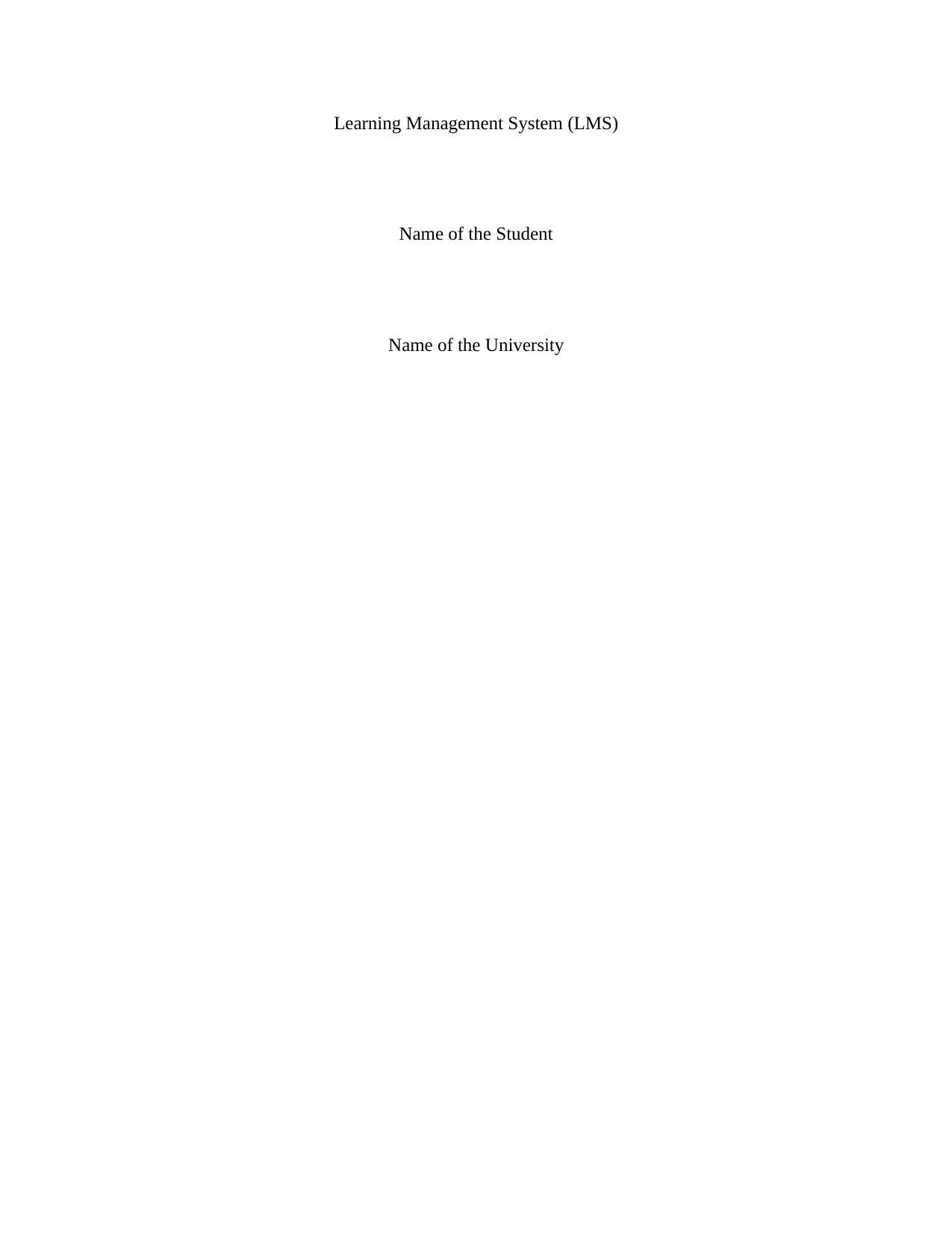
Learning Management System (LMS)
Name of the Student
Name of the University
Name of the Student
Name of the University
Paraphrase This Document
Need a fresh take? Get an instant paraphrase of this document with our AI Paraphraser
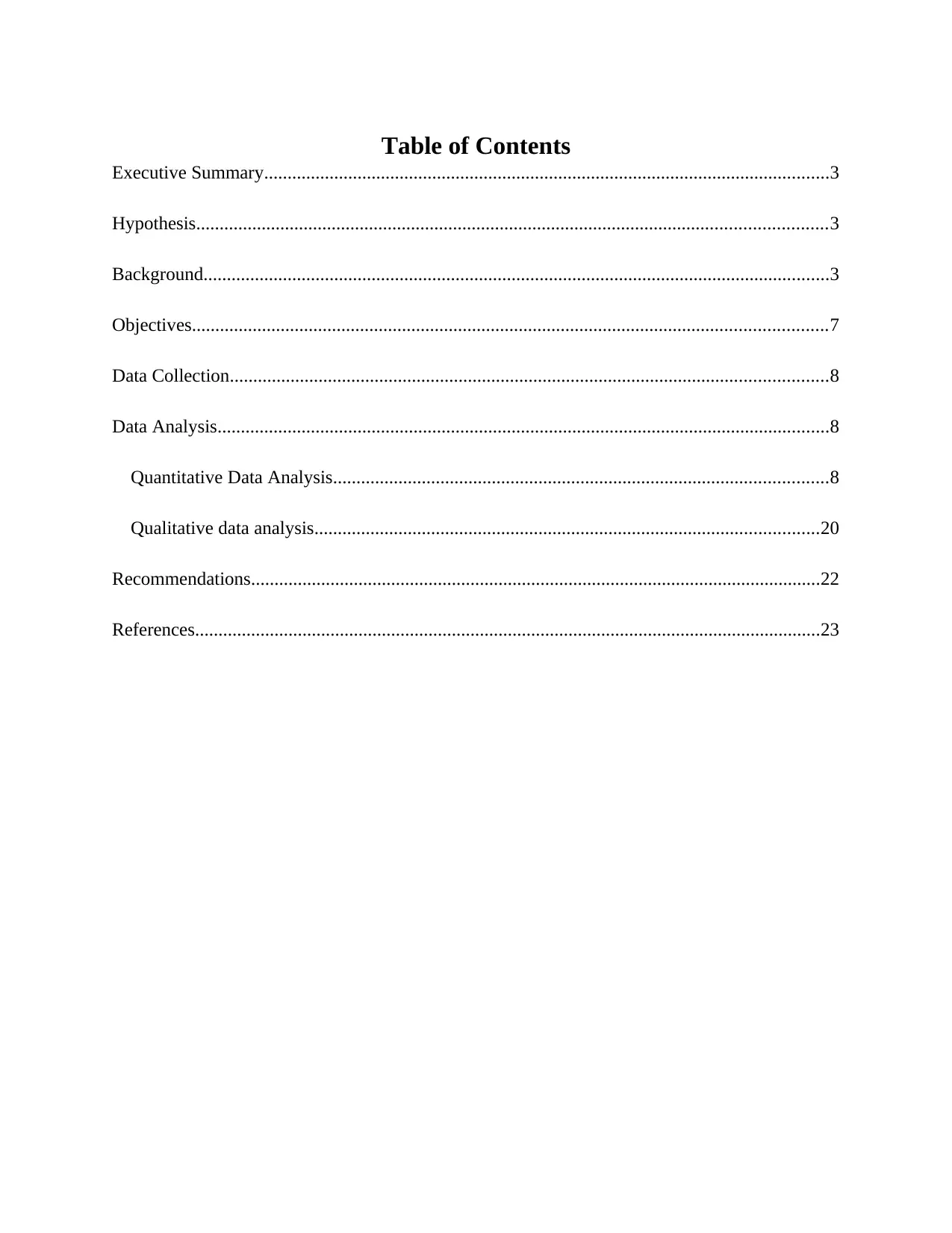
Table of Contents
Executive Summary.........................................................................................................................3
Hypothesis.......................................................................................................................................3
Background......................................................................................................................................3
Objectives........................................................................................................................................7
Data Collection................................................................................................................................8
Data Analysis...................................................................................................................................8
Quantitative Data Analysis..........................................................................................................8
Qualitative data analysis............................................................................................................20
Recommendations..........................................................................................................................22
References......................................................................................................................................23
Executive Summary.........................................................................................................................3
Hypothesis.......................................................................................................................................3
Background......................................................................................................................................3
Objectives........................................................................................................................................7
Data Collection................................................................................................................................8
Data Analysis...................................................................................................................................8
Quantitative Data Analysis..........................................................................................................8
Qualitative data analysis............................................................................................................20
Recommendations..........................................................................................................................22
References......................................................................................................................................23
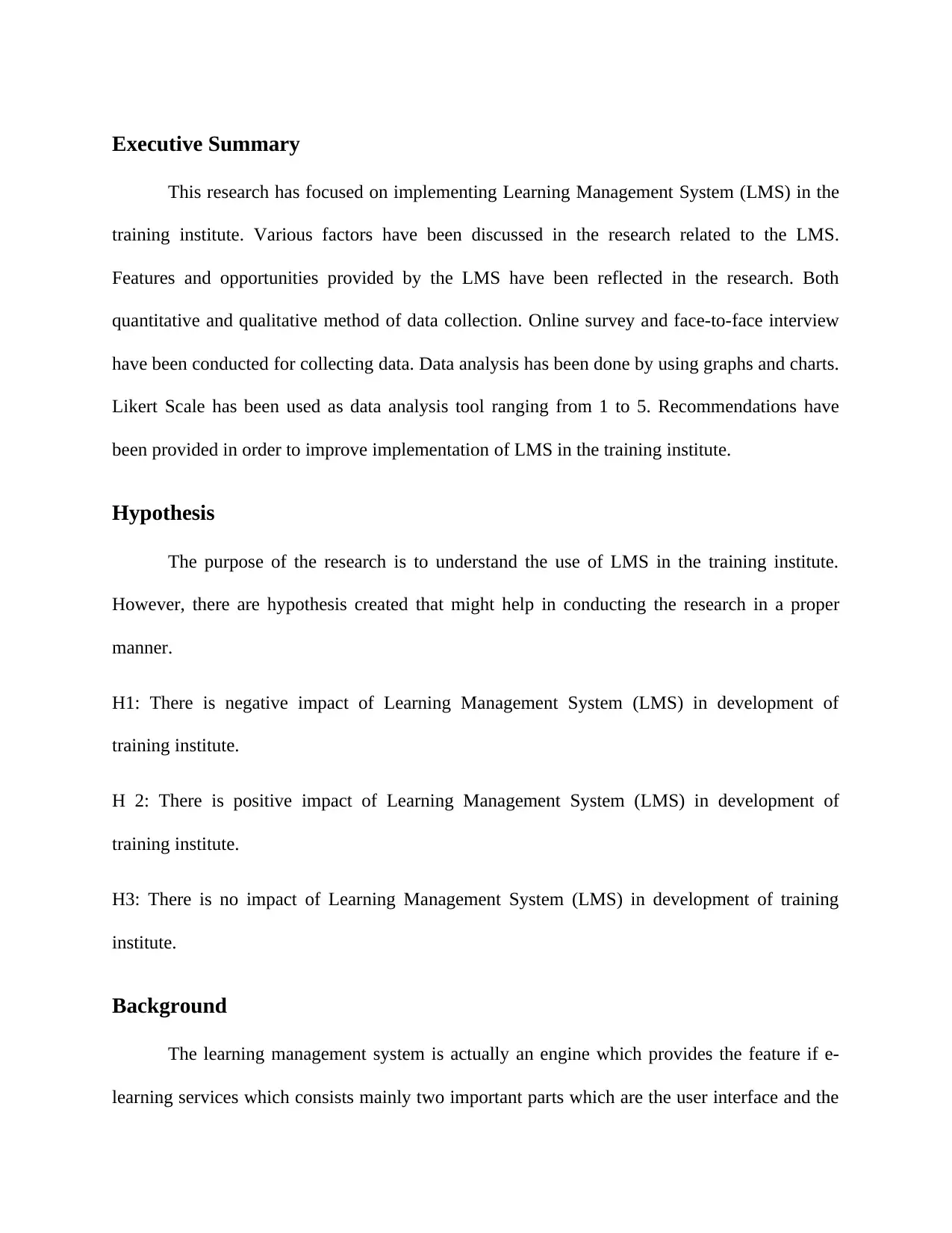
Executive Summary
This research has focused on implementing Learning Management System (LMS) in the
training institute. Various factors have been discussed in the research related to the LMS.
Features and opportunities provided by the LMS have been reflected in the research. Both
quantitative and qualitative method of data collection. Online survey and face-to-face interview
have been conducted for collecting data. Data analysis has been done by using graphs and charts.
Likert Scale has been used as data analysis tool ranging from 1 to 5. Recommendations have
been provided in order to improve implementation of LMS in the training institute.
Hypothesis
The purpose of the research is to understand the use of LMS in the training institute.
However, there are hypothesis created that might help in conducting the research in a proper
manner.
H1: There is negative impact of Learning Management System (LMS) in development of
training institute.
H 2: There is positive impact of Learning Management System (LMS) in development of
training institute.
H3: There is no impact of Learning Management System (LMS) in development of training
institute.
Background
The learning management system is actually an engine which provides the feature if e-
learning services which consists mainly two important parts which are the user interface and the
This research has focused on implementing Learning Management System (LMS) in the
training institute. Various factors have been discussed in the research related to the LMS.
Features and opportunities provided by the LMS have been reflected in the research. Both
quantitative and qualitative method of data collection. Online survey and face-to-face interview
have been conducted for collecting data. Data analysis has been done by using graphs and charts.
Likert Scale has been used as data analysis tool ranging from 1 to 5. Recommendations have
been provided in order to improve implementation of LMS in the training institute.
Hypothesis
The purpose of the research is to understand the use of LMS in the training institute.
However, there are hypothesis created that might help in conducting the research in a proper
manner.
H1: There is negative impact of Learning Management System (LMS) in development of
training institute.
H 2: There is positive impact of Learning Management System (LMS) in development of
training institute.
H3: There is no impact of Learning Management System (LMS) in development of training
institute.
Background
The learning management system is actually an engine which provides the feature if e-
learning services which consists mainly two important parts which are the user interface and the
⊘ This is a preview!⊘
Do you want full access?
Subscribe today to unlock all pages.

Trusted by 1+ million students worldwide
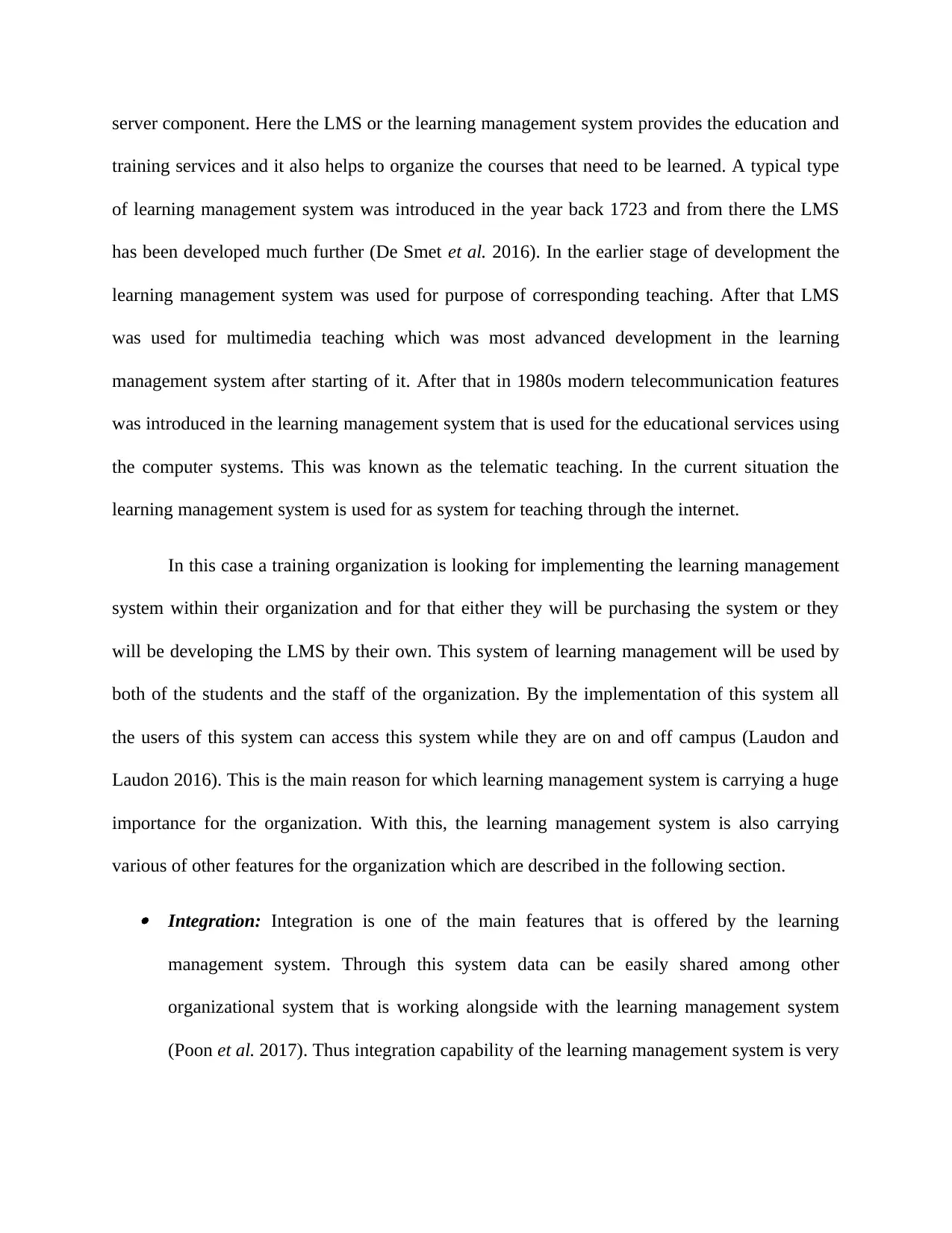
server component. Here the LMS or the learning management system provides the education and
training services and it also helps to organize the courses that need to be learned. A typical type
of learning management system was introduced in the year back 1723 and from there the LMS
has been developed much further (De Smet et al. 2016). In the earlier stage of development the
learning management system was used for purpose of corresponding teaching. After that LMS
was used for multimedia teaching which was most advanced development in the learning
management system after starting of it. After that in 1980s modern telecommunication features
was introduced in the learning management system that is used for the educational services using
the computer systems. This was known as the telematic teaching. In the current situation the
learning management system is used for as system for teaching through the internet.
In this case a training organization is looking for implementing the learning management
system within their organization and for that either they will be purchasing the system or they
will be developing the LMS by their own. This system of learning management will be used by
both of the students and the staff of the organization. By the implementation of this system all
the users of this system can access this system while they are on and off campus (Laudon and
Laudon 2016). This is the main reason for which learning management system is carrying a huge
importance for the organization. With this, the learning management system is also carrying
various of other features for the organization which are described in the following section.
Integration: Integration is one of the main features that is offered by the learning
management system. Through this system data can be easily shared among other
organizational system that is working alongside with the learning management system
(Poon et al. 2017). Thus integration capability of the learning management system is very
training services and it also helps to organize the courses that need to be learned. A typical type
of learning management system was introduced in the year back 1723 and from there the LMS
has been developed much further (De Smet et al. 2016). In the earlier stage of development the
learning management system was used for purpose of corresponding teaching. After that LMS
was used for multimedia teaching which was most advanced development in the learning
management system after starting of it. After that in 1980s modern telecommunication features
was introduced in the learning management system that is used for the educational services using
the computer systems. This was known as the telematic teaching. In the current situation the
learning management system is used for as system for teaching through the internet.
In this case a training organization is looking for implementing the learning management
system within their organization and for that either they will be purchasing the system or they
will be developing the LMS by their own. This system of learning management will be used by
both of the students and the staff of the organization. By the implementation of this system all
the users of this system can access this system while they are on and off campus (Laudon and
Laudon 2016). This is the main reason for which learning management system is carrying a huge
importance for the organization. With this, the learning management system is also carrying
various of other features for the organization which are described in the following section.
Integration: Integration is one of the main features that is offered by the learning
management system. Through this system data can be easily shared among other
organizational system that is working alongside with the learning management system
(Poon et al. 2017). Thus integration capability of the learning management system is very
Paraphrase This Document
Need a fresh take? Get an instant paraphrase of this document with our AI Paraphraser
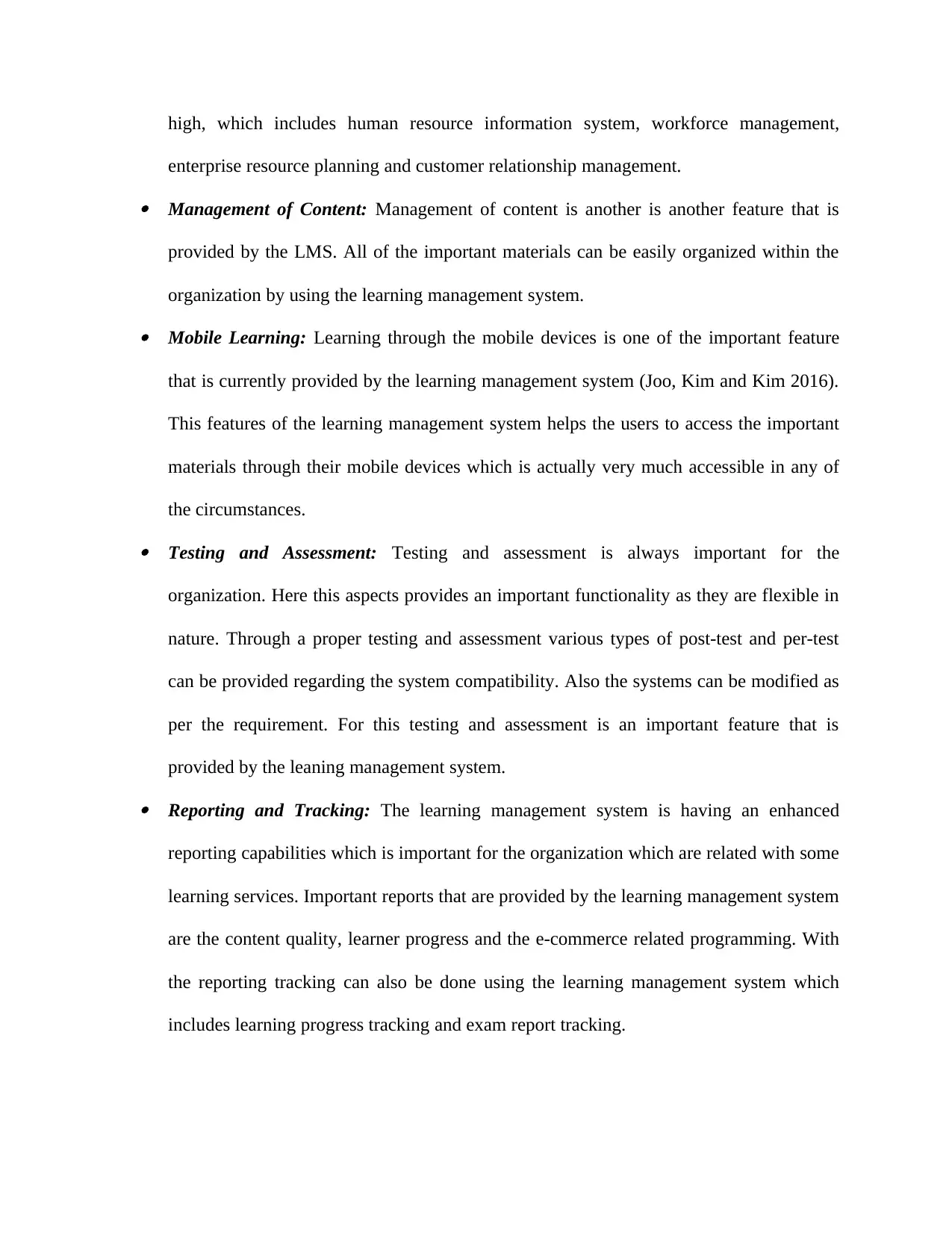
high, which includes human resource information system, workforce management,
enterprise resource planning and customer relationship management. Management of Content: Management of content is another is another feature that is
provided by the LMS. All of the important materials can be easily organized within the
organization by using the learning management system. Mobile Learning: Learning through the mobile devices is one of the important feature
that is currently provided by the learning management system (Joo, Kim and Kim 2016).
This features of the learning management system helps the users to access the important
materials through their mobile devices which is actually very much accessible in any of
the circumstances. Testing and Assessment: Testing and assessment is always important for the
organization. Here this aspects provides an important functionality as they are flexible in
nature. Through a proper testing and assessment various types of post-test and per-test
can be provided regarding the system compatibility. Also the systems can be modified as
per the requirement. For this testing and assessment is an important feature that is
provided by the leaning management system. Reporting and Tracking: The learning management system is having an enhanced
reporting capabilities which is important for the organization which are related with some
learning services. Important reports that are provided by the learning management system
are the content quality, learner progress and the e-commerce related programming. With
the reporting tracking can also be done using the learning management system which
includes learning progress tracking and exam report tracking.
enterprise resource planning and customer relationship management. Management of Content: Management of content is another is another feature that is
provided by the LMS. All of the important materials can be easily organized within the
organization by using the learning management system. Mobile Learning: Learning through the mobile devices is one of the important feature
that is currently provided by the learning management system (Joo, Kim and Kim 2016).
This features of the learning management system helps the users to access the important
materials through their mobile devices which is actually very much accessible in any of
the circumstances. Testing and Assessment: Testing and assessment is always important for the
organization. Here this aspects provides an important functionality as they are flexible in
nature. Through a proper testing and assessment various types of post-test and per-test
can be provided regarding the system compatibility. Also the systems can be modified as
per the requirement. For this testing and assessment is an important feature that is
provided by the leaning management system. Reporting and Tracking: The learning management system is having an enhanced
reporting capabilities which is important for the organization which are related with some
learning services. Important reports that are provided by the learning management system
are the content quality, learner progress and the e-commerce related programming. With
the reporting tracking can also be done using the learning management system which
includes learning progress tracking and exam report tracking.
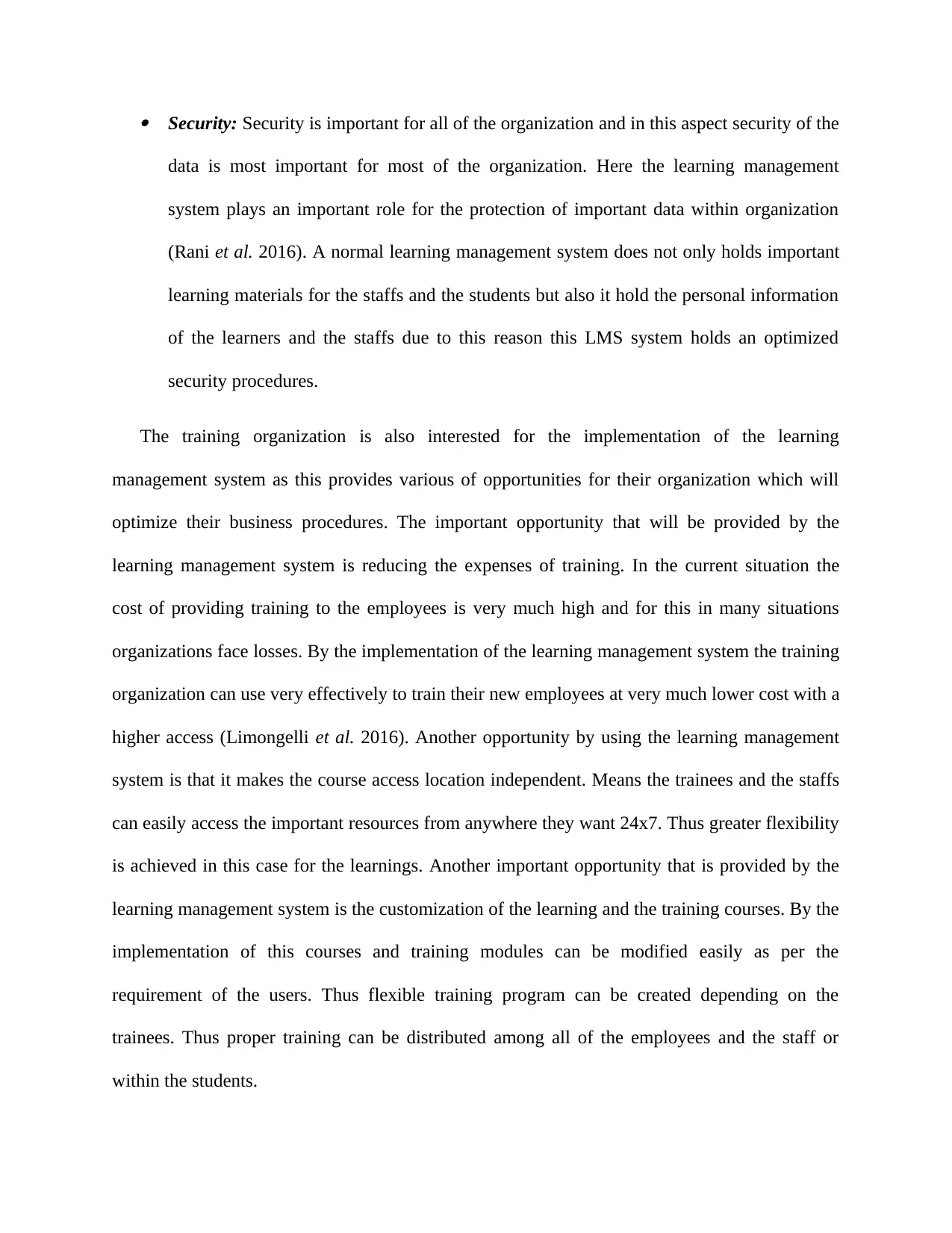
Security: Security is important for all of the organization and in this aspect security of the
data is most important for most of the organization. Here the learning management
system plays an important role for the protection of important data within organization
(Rani et al. 2016). A normal learning management system does not only holds important
learning materials for the staffs and the students but also it hold the personal information
of the learners and the staffs due to this reason this LMS system holds an optimized
security procedures.
The training organization is also interested for the implementation of the learning
management system as this provides various of opportunities for their organization which will
optimize their business procedures. The important opportunity that will be provided by the
learning management system is reducing the expenses of training. In the current situation the
cost of providing training to the employees is very much high and for this in many situations
organizations face losses. By the implementation of the learning management system the training
organization can use very effectively to train their new employees at very much lower cost with a
higher access (Limongelli et al. 2016). Another opportunity by using the learning management
system is that it makes the course access location independent. Means the trainees and the staffs
can easily access the important resources from anywhere they want 24x7. Thus greater flexibility
is achieved in this case for the learnings. Another important opportunity that is provided by the
learning management system is the customization of the learning and the training courses. By the
implementation of this courses and training modules can be modified easily as per the
requirement of the users. Thus flexible training program can be created depending on the
trainees. Thus proper training can be distributed among all of the employees and the staff or
within the students.
data is most important for most of the organization. Here the learning management
system plays an important role for the protection of important data within organization
(Rani et al. 2016). A normal learning management system does not only holds important
learning materials for the staffs and the students but also it hold the personal information
of the learners and the staffs due to this reason this LMS system holds an optimized
security procedures.
The training organization is also interested for the implementation of the learning
management system as this provides various of opportunities for their organization which will
optimize their business procedures. The important opportunity that will be provided by the
learning management system is reducing the expenses of training. In the current situation the
cost of providing training to the employees is very much high and for this in many situations
organizations face losses. By the implementation of the learning management system the training
organization can use very effectively to train their new employees at very much lower cost with a
higher access (Limongelli et al. 2016). Another opportunity by using the learning management
system is that it makes the course access location independent. Means the trainees and the staffs
can easily access the important resources from anywhere they want 24x7. Thus greater flexibility
is achieved in this case for the learnings. Another important opportunity that is provided by the
learning management system is the customization of the learning and the training courses. By the
implementation of this courses and training modules can be modified easily as per the
requirement of the users. Thus flexible training program can be created depending on the
trainees. Thus proper training can be distributed among all of the employees and the staff or
within the students.
⊘ This is a preview!⊘
Do you want full access?
Subscribe today to unlock all pages.

Trusted by 1+ million students worldwide
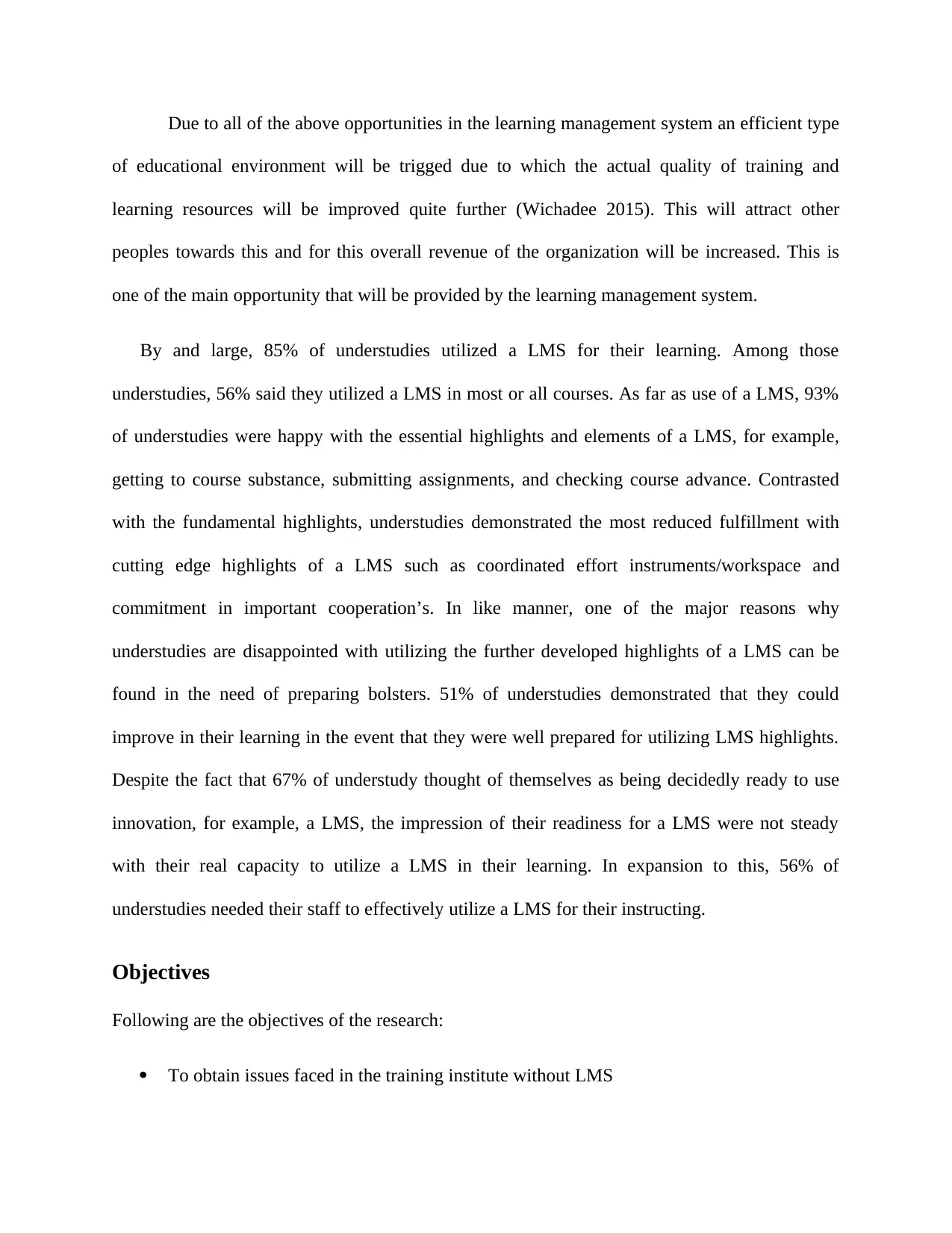
Due to all of the above opportunities in the learning management system an efficient type
of educational environment will be trigged due to which the actual quality of training and
learning resources will be improved quite further (Wichadee 2015). This will attract other
peoples towards this and for this overall revenue of the organization will be increased. This is
one of the main opportunity that will be provided by the learning management system.
By and large, 85% of understudies utilized a LMS for their learning. Among those
understudies, 56% said they utilized a LMS in most or all courses. As far as use of a LMS, 93%
of understudies were happy with the essential highlights and elements of a LMS, for example,
getting to course substance, submitting assignments, and checking course advance. Contrasted
with the fundamental highlights, understudies demonstrated the most reduced fulfillment with
cutting edge highlights of a LMS such as coordinated effort instruments/workspace and
commitment in important cooperation’s. In like manner, one of the major reasons why
understudies are disappointed with utilizing the further developed highlights of a LMS can be
found in the need of preparing bolsters. 51% of understudies demonstrated that they could
improve in their learning in the event that they were well prepared for utilizing LMS highlights.
Despite the fact that 67% of understudy thought of themselves as being decidedly ready to use
innovation, for example, a LMS, the impression of their readiness for a LMS were not steady
with their real capacity to utilize a LMS in their learning. In expansion to this, 56% of
understudies needed their staff to effectively utilize a LMS for their instructing.
Objectives
Following are the objectives of the research:
To obtain issues faced in the training institute without LMS
of educational environment will be trigged due to which the actual quality of training and
learning resources will be improved quite further (Wichadee 2015). This will attract other
peoples towards this and for this overall revenue of the organization will be increased. This is
one of the main opportunity that will be provided by the learning management system.
By and large, 85% of understudies utilized a LMS for their learning. Among those
understudies, 56% said they utilized a LMS in most or all courses. As far as use of a LMS, 93%
of understudies were happy with the essential highlights and elements of a LMS, for example,
getting to course substance, submitting assignments, and checking course advance. Contrasted
with the fundamental highlights, understudies demonstrated the most reduced fulfillment with
cutting edge highlights of a LMS such as coordinated effort instruments/workspace and
commitment in important cooperation’s. In like manner, one of the major reasons why
understudies are disappointed with utilizing the further developed highlights of a LMS can be
found in the need of preparing bolsters. 51% of understudies demonstrated that they could
improve in their learning in the event that they were well prepared for utilizing LMS highlights.
Despite the fact that 67% of understudy thought of themselves as being decidedly ready to use
innovation, for example, a LMS, the impression of their readiness for a LMS were not steady
with their real capacity to utilize a LMS in their learning. In expansion to this, 56% of
understudies needed their staff to effectively utilize a LMS for their instructing.
Objectives
Following are the objectives of the research:
To obtain issues faced in the training institute without LMS
Paraphrase This Document
Need a fresh take? Get an instant paraphrase of this document with our AI Paraphraser
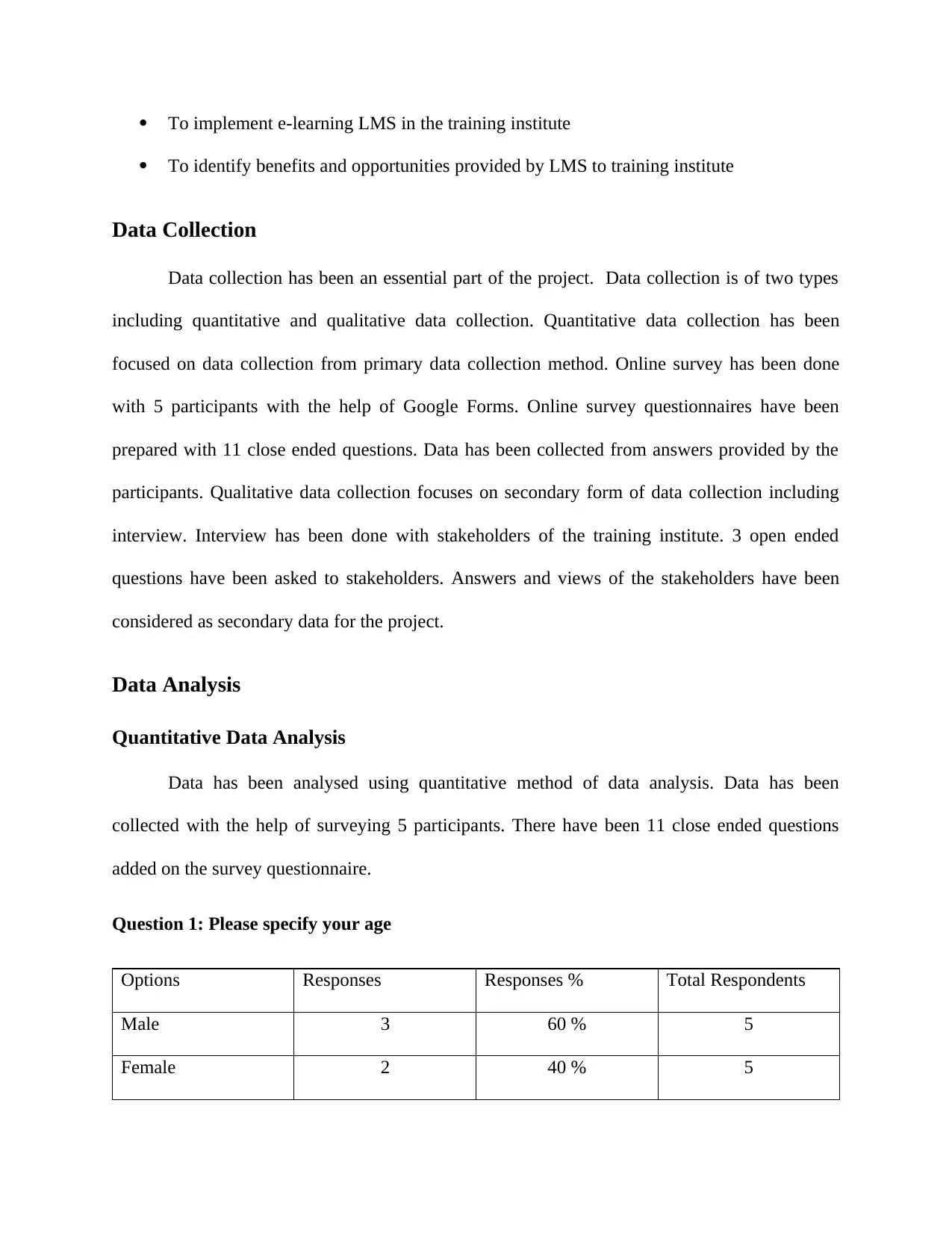
To implement e-learning LMS in the training institute
To identify benefits and opportunities provided by LMS to training institute
Data Collection
Data collection has been an essential part of the project. Data collection is of two types
including quantitative and qualitative data collection. Quantitative data collection has been
focused on data collection from primary data collection method. Online survey has been done
with 5 participants with the help of Google Forms. Online survey questionnaires have been
prepared with 11 close ended questions. Data has been collected from answers provided by the
participants. Qualitative data collection focuses on secondary form of data collection including
interview. Interview has been done with stakeholders of the training institute. 3 open ended
questions have been asked to stakeholders. Answers and views of the stakeholders have been
considered as secondary data for the project.
Data Analysis
Quantitative Data Analysis
Data has been analysed using quantitative method of data analysis. Data has been
collected with the help of surveying 5 participants. There have been 11 close ended questions
added on the survey questionnaire.
Question 1: Please specify your age
Options Responses Responses % Total Respondents
Male 3 60 % 5
Female 2 40 % 5
To identify benefits and opportunities provided by LMS to training institute
Data Collection
Data collection has been an essential part of the project. Data collection is of two types
including quantitative and qualitative data collection. Quantitative data collection has been
focused on data collection from primary data collection method. Online survey has been done
with 5 participants with the help of Google Forms. Online survey questionnaires have been
prepared with 11 close ended questions. Data has been collected from answers provided by the
participants. Qualitative data collection focuses on secondary form of data collection including
interview. Interview has been done with stakeholders of the training institute. 3 open ended
questions have been asked to stakeholders. Answers and views of the stakeholders have been
considered as secondary data for the project.
Data Analysis
Quantitative Data Analysis
Data has been analysed using quantitative method of data analysis. Data has been
collected with the help of surveying 5 participants. There have been 11 close ended questions
added on the survey questionnaire.
Question 1: Please specify your age
Options Responses Responses % Total Respondents
Male 3 60 % 5
Female 2 40 % 5
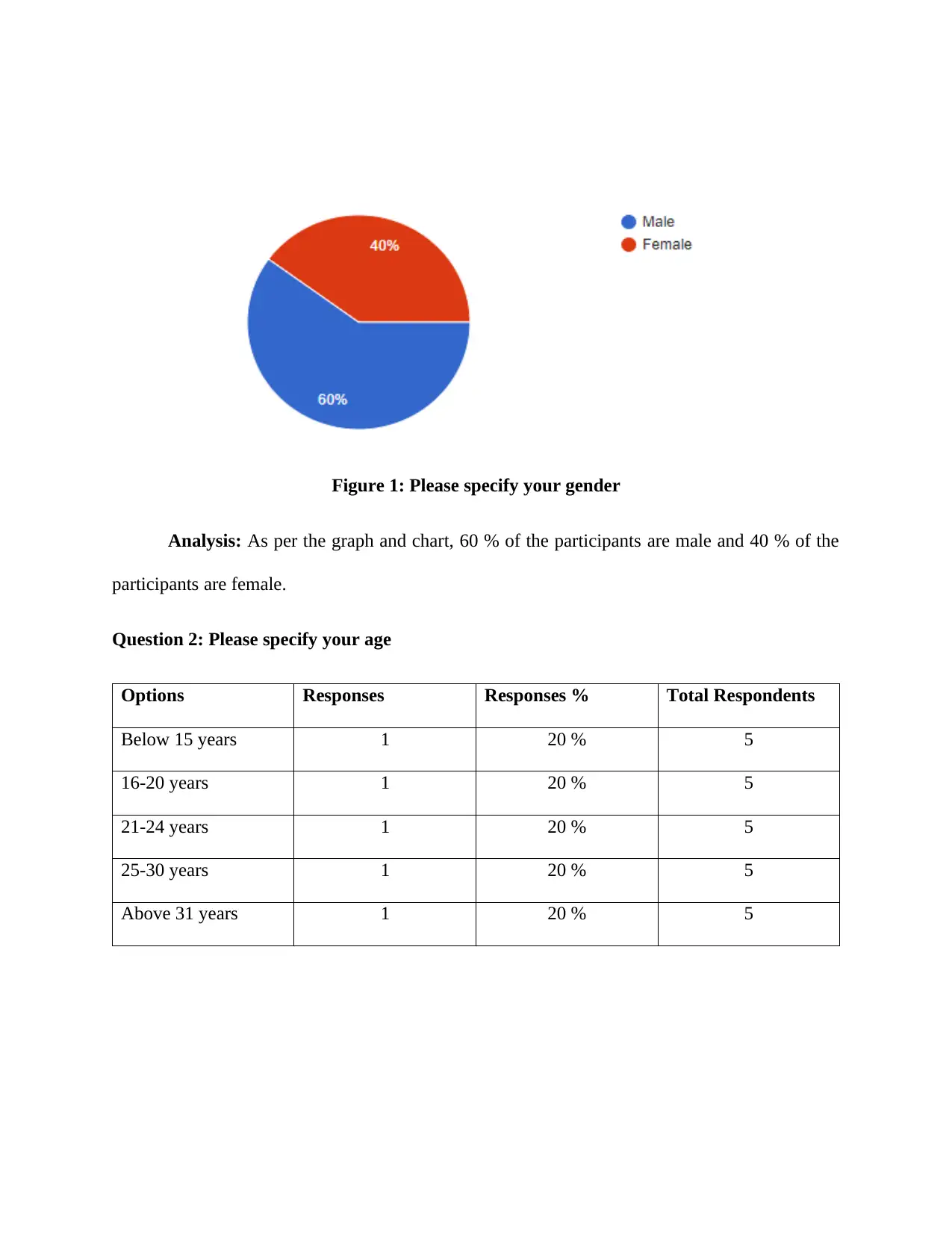
Figure 1: Please specify your gender
Analysis: As per the graph and chart, 60 % of the participants are male and 40 % of the
participants are female.
Question 2: Please specify your age
Options Responses Responses % Total Respondents
Below 15 years 1 20 % 5
16-20 years 1 20 % 5
21-24 years 1 20 % 5
25-30 years 1 20 % 5
Above 31 years 1 20 % 5
Analysis: As per the graph and chart, 60 % of the participants are male and 40 % of the
participants are female.
Question 2: Please specify your age
Options Responses Responses % Total Respondents
Below 15 years 1 20 % 5
16-20 years 1 20 % 5
21-24 years 1 20 % 5
25-30 years 1 20 % 5
Above 31 years 1 20 % 5
⊘ This is a preview!⊘
Do you want full access?
Subscribe today to unlock all pages.

Trusted by 1+ million students worldwide
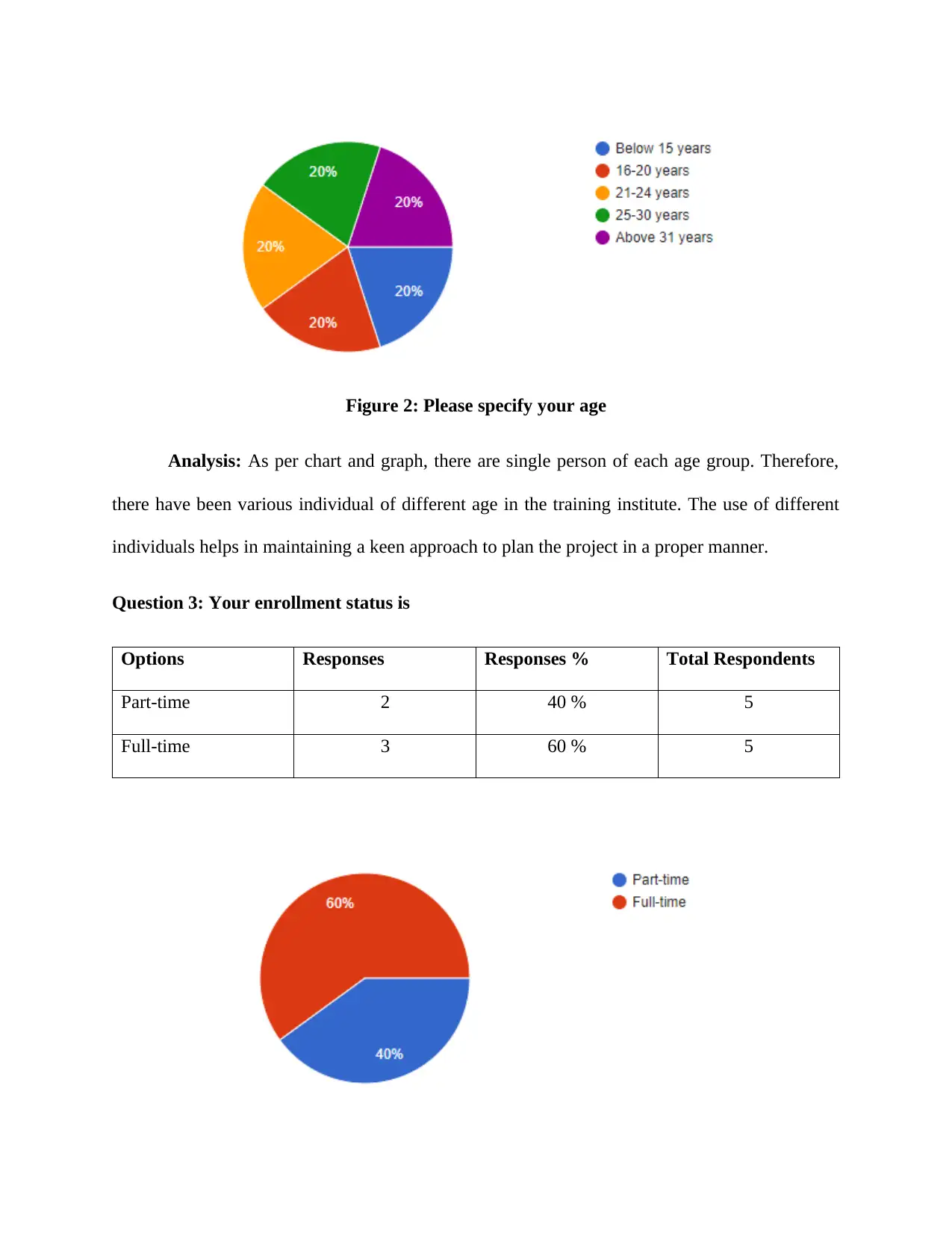
Figure 2: Please specify your age
Analysis: As per chart and graph, there are single person of each age group. Therefore,
there have been various individual of different age in the training institute. The use of different
individuals helps in maintaining a keen approach to plan the project in a proper manner.
Question 3: Your enrollment status is
Options Responses Responses % Total Respondents
Part-time 2 40 % 5
Full-time 3 60 % 5
Analysis: As per chart and graph, there are single person of each age group. Therefore,
there have been various individual of different age in the training institute. The use of different
individuals helps in maintaining a keen approach to plan the project in a proper manner.
Question 3: Your enrollment status is
Options Responses Responses % Total Respondents
Part-time 2 40 % 5
Full-time 3 60 % 5
Paraphrase This Document
Need a fresh take? Get an instant paraphrase of this document with our AI Paraphraser
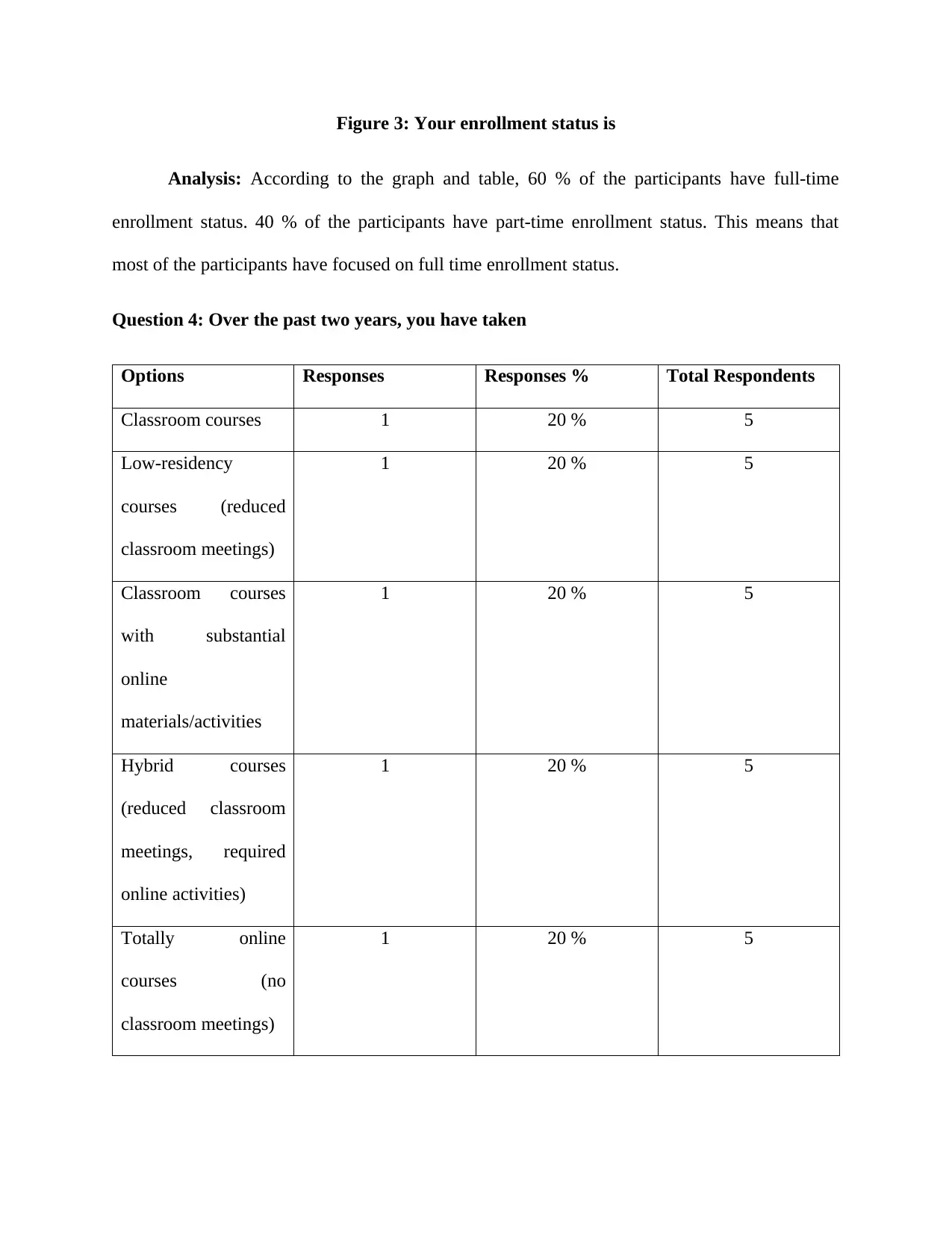
Figure 3: Your enrollment status is
Analysis: According to the graph and table, 60 % of the participants have full-time
enrollment status. 40 % of the participants have part-time enrollment status. This means that
most of the participants have focused on full time enrollment status.
Question 4: Over the past two years, you have taken
Options Responses Responses % Total Respondents
Classroom courses 1 20 % 5
Low-residency
courses (reduced
classroom meetings)
1 20 % 5
Classroom courses
with substantial
online
materials/activities
1 20 % 5
Hybrid courses
(reduced classroom
meetings, required
online activities)
1 20 % 5
Totally online
courses (no
classroom meetings)
1 20 % 5
Analysis: According to the graph and table, 60 % of the participants have full-time
enrollment status. 40 % of the participants have part-time enrollment status. This means that
most of the participants have focused on full time enrollment status.
Question 4: Over the past two years, you have taken
Options Responses Responses % Total Respondents
Classroom courses 1 20 % 5
Low-residency
courses (reduced
classroom meetings)
1 20 % 5
Classroom courses
with substantial
online
materials/activities
1 20 % 5
Hybrid courses
(reduced classroom
meetings, required
online activities)
1 20 % 5
Totally online
courses (no
classroom meetings)
1 20 % 5
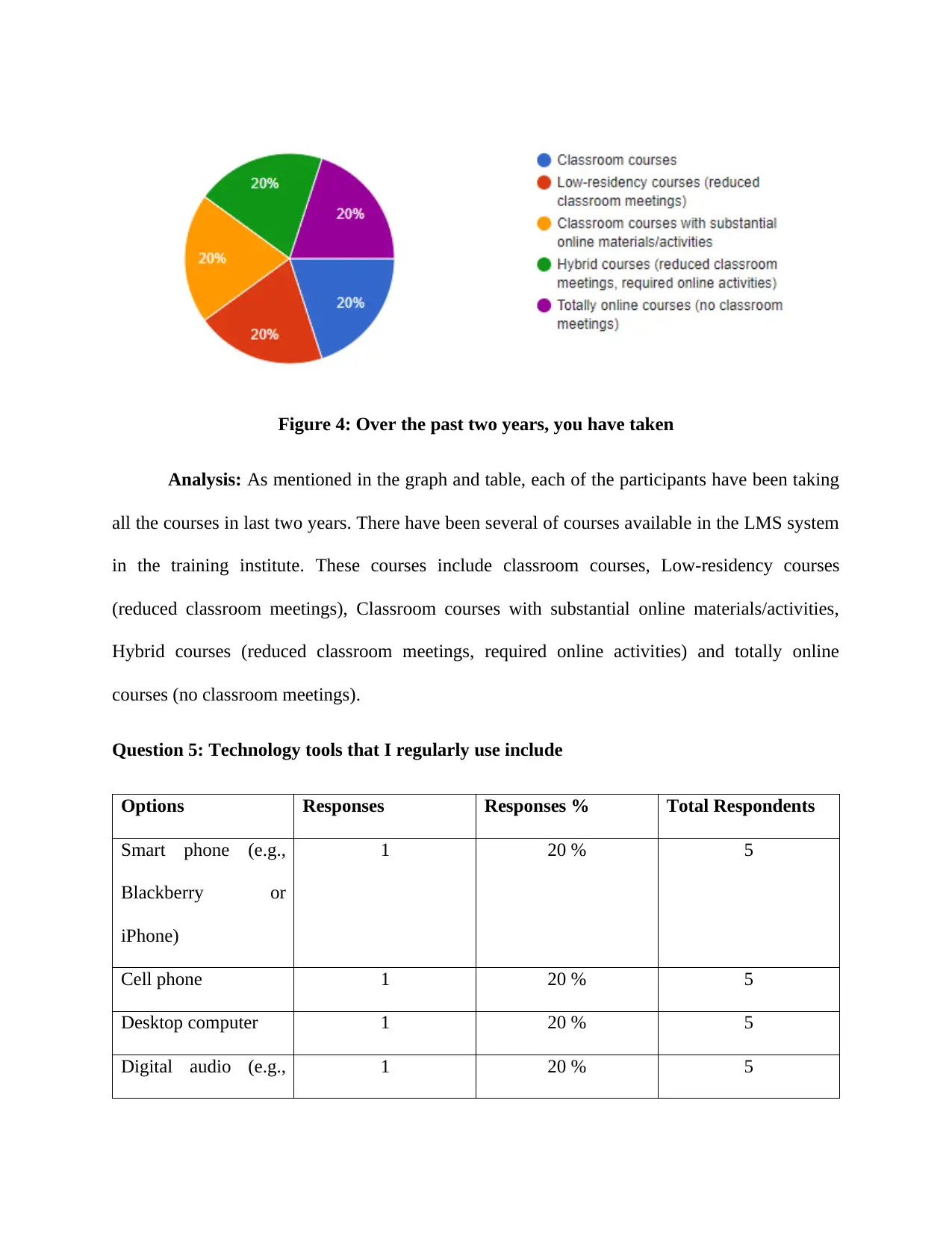
Figure 4: Over the past two years, you have taken
Analysis: As mentioned in the graph and table, each of the participants have been taking
all the courses in last two years. There have been several of courses available in the LMS system
in the training institute. These courses include classroom courses, Low-residency courses
(reduced classroom meetings), Classroom courses with substantial online materials/activities,
Hybrid courses (reduced classroom meetings, required online activities) and totally online
courses (no classroom meetings).
Question 5: Technology tools that I regularly use include
Options Responses Responses % Total Respondents
Smart phone (e.g.,
Blackberry or
iPhone)
1 20 % 5
Cell phone 1 20 % 5
Desktop computer 1 20 % 5
Digital audio (e.g., 1 20 % 5
Analysis: As mentioned in the graph and table, each of the participants have been taking
all the courses in last two years. There have been several of courses available in the LMS system
in the training institute. These courses include classroom courses, Low-residency courses
(reduced classroom meetings), Classroom courses with substantial online materials/activities,
Hybrid courses (reduced classroom meetings, required online activities) and totally online
courses (no classroom meetings).
Question 5: Technology tools that I regularly use include
Options Responses Responses % Total Respondents
Smart phone (e.g.,
Blackberry or
iPhone)
1 20 % 5
Cell phone 1 20 % 5
Desktop computer 1 20 % 5
Digital audio (e.g., 1 20 % 5
⊘ This is a preview!⊘
Do you want full access?
Subscribe today to unlock all pages.

Trusted by 1+ million students worldwide
1 out of 23
Related Documents
Your All-in-One AI-Powered Toolkit for Academic Success.
+13062052269
info@desklib.com
Available 24*7 on WhatsApp / Email
![[object Object]](/_next/static/media/star-bottom.7253800d.svg)
Unlock your academic potential
Copyright © 2020–2025 A2Z Services. All Rights Reserved. Developed and managed by ZUCOL.




